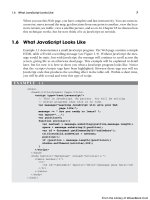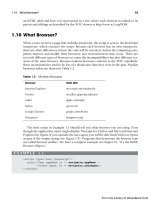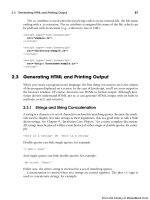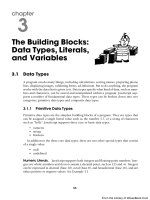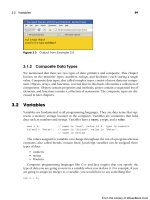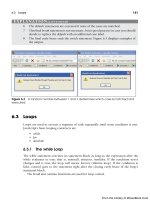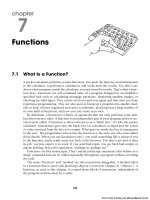Học JavaScript qua ví dụ part 3 pps
Bạn đang xem bản rút gọn của tài liệu. Xem và tải ngay bản đầy đủ của tài liệu tại đây (1.19 MB, 6 trang )
ptg
1.10 What Browser? 15
an HTML table and how it is represented as a tree where each element is related to its
parent and siblings as described by the W3C shown at />1.10 What Browser?
When a user receives a page that includes JavaScript, the script is sent to the JavaScript
interpreter, which executes the script. Because each browser has its own interpreter,
there are often differences in how the code will be executed. And as the competing com-
panies improve and modify their browsers, new inconsistencies may occur. There are
not only different types of browsers to cause the incompatibilities but also different ver-
sions of the same browser. Because modern browsers conform to the W3C standards,
these inconsistencies tend to be less of a distraction than they were in the past. Popular
browsers today are shown in Table 1.2.
The little script in Example 1.3 should tell you what browser you are using. Even
though the application name might display Netscape for Firefox and Microsoft Internet
Explorer for Opera, if you examine the user agent, you will be able find Firefox or Opera
as part of the output string (see Figure 1.9). Programs that determine the browser type
are called browser sniffers. We have a complete example in Chapter 10, “It’s the BOM!
Browser Objects.”
Table 1.2 Modern Browsers
Browser Web Site
Internet Explorer microsoft.com/windows/ie
Firefox mozilla.org/products/firefox
Safari apple.com/safari
Opera opera.com
Google Chrome google.com/chrome
Konqueror konqueror.org/
EXAMPLE 1.3
<script type="text/javascript">
alert("User appName is "+ navigator.appName +
"\nUser agent is "+ navigator.userAgent);
</script>
From the Library of WoweBook.Com
ptg
16 Chapter 1 • Introduction to JavaScript
1.10.1 Versions of JavaScript
JavaScript has a history. Invented by Netscape, the first version was JavaScript 1.0. It was
new and buggy and has long since been replaced by much cleaner versions. Microsoft
has a scripting language comparable to JavaScript called JScript. Table 1.3 lists versions
of both JavaScript and JScript. For a discussion of JavaScript versions and development
see />Figure 1.9 Output from Example 1.3.
Table 1.3 JavaScript Versions
JavaScript or
JScript Version Browsers Supported
JavaScript 1.0 1996 Netscape Navigator 2.0, Internet Explorer 3.0
JavaScript 1.1 1996 Netscape Navigator 3.0, Internet Explorer 4.0
JavaScript 1.2 1997 Netscape Navigator 4.0–4.05, Internet Explorer 4.0
From the Library of WoweBook.Com
ptg
1.10 What Browser? 17
JavaScript 1.3 1998 ECMA-232, Netscape Navigator 4.06–4.7x, Internet Explorer 5.0
JavaScript 1.5 2000 ECMA-232, Netscape Navigator 6.0+, Mozilla Firefox, Internet
Explorer 5.5+, JScript 5.5, 5.6, 5.7, 6
JavaScript 1.6 2006 Mozilla Firefox, Safari
JavaScript 1.7 2006 Mozilla Firefox, Safari, Google Chrome
JavaScript 1.8 2008 Mozilla Firefox
JavaScript is supported by Firefox, Explorer, Opera, and all newer versions of these browsers. In addition,
HotJava 3 supports JavaScript, as do iCab for the Mac, WebTV, OmniWeb for OS X, QNX Voyager and
Konqueror for the Linux KDE environment. NetBox for TV, AWeb and Voyager 3 for Amiga, and SEGA
Dreamcast and ANT Fresco on RISC OS also support JavaScript.
Figure 1.10 JavaScript2 and the Web, an informative paper by Brendan Eich.
Table 1.3 JavaScript Versions (continued)
JavaScript or
JScript Version Browsers Supported
From the Library of WoweBook.Com
ptg
18 Chapter 1 • Introduction to JavaScript
So where is JavaScript now? As of December 2009, the ECMA-262 Standard is in its 5th
edition. JavaScript is a dialect of ECMAScript, but JavaScript 1.8 is comparable to
ECMAScript, edition 3 and is currently the most widely used version (JavaScript 1.9 is
available for download). To understand some of the proposals for a JavaScript2 version
(ECMAScript Edition 4), Brian Eich, the creator of JavaScript, wrote an interesting arti-
cle a few years ago that he published on the Web. If nothing else, it tells you some of the
pros and cons of the current state of the JavaScript language and the obstacles faced in
trying to change it. See Figure 1.10.
1.10.2 Does Your Browser Follow the Standard?
Modern browsers are using versions of JavaScript 1.5 or above, which generally follow
the standards set by the W3C. The snippet of code in Example 1.4 tests to see if you are
using a modern version of JavaScript that follows the standard DOM (see Figure 1.11).
Both the getElementById and createTextNode are part of the W3C standard, which sup-
ports the DOM.
1.10.3 Is JavaScript Enabled on Your Browser?
To see if JavaScript is enabled on your browser, you can check the options menu of
Firefox by going to the Tools menu/Options/Content. If using Apple’s Safari browser,
go to Safari menu/Preferences/Security and with Internet Explorer, go to the Tools
menu/Internet Options/Security/Custom Level and enable Active scripting (see Figure
1.12). If using Opera go to the Opera menu/Preferences/Advanced/Content and click
Enable JavaScript. An easy way to test if your browser has JavaScript enabled is to go
to the Web site and follow directions (see Fig-
ure 1.13).
EXAMPLE 1.4
<script type="text/javascript">
if (document.getElementById && document.createTextNode){
alert("DOM supported by " + navigator.appName);
}
</script>
Figure 1.11 Internet Explorer supports the standard.
From the Library of WoweBook.Com
ptg
1.10 What Browser? 19
Figure 1.12 Enabling JavaScript on Microsoft Internet Explorer.
Figure 1.13 Is your browser JavaScript enabled?
From the Library of WoweBook.Com
ptg
20 Chapter 1 • Introduction to JavaScript
1.11 Where to Put JavaScript
Before learning JavaScript, you should be familiar with HTML and how to create an
HTML document. This doesn’t mean that you have to be an expert, but you should be
familiar with the structure of HTML documents and how the tags are used to display
various kinds of content on your browser. Once you have a static HTML document, then
adding basic JavaScript statements is quite easy. (Go to for an
excellent HTML tutorial.) In this text we have devoted a separate chapter to CSS. CSS
allows you to control the style and layout of your Web page by changing fonts, colors,
backgrounds, margins, and so on in a single file. With HTML, CSS, and JavaScript you
can create a Web site with structure, style, and action.
Client-side JavaScript programs are embedded in an HTML document between
HTML head tags <head> and </head> or between the body tags <body> and </body>.
Many developers prefer to put JavaScript code within the <head> tags, and at times, as
you will see later, it is the best place to store function definitions and objects. If you want
text displayed at a specific spot in the document, you might want to place the JavaScript
code within the <body> tags (as shown in Example 1.5). Or you might have multiple
scripts within a page, and place the JavaScript code within both the <head> and <body>
tags. In either case, a JavaScript program starts with a <script> tag, and ends with a
</script> tag. And if the JavaScript code is going to be long and involved, or may be
shared by multiple pages, it should be placed in an external file (text file ending in .js)
and loaded into the page. In fact, once you start developing Web pages with JavasScript,
it is customary to separate the HTML/CSS content from the programming logic (Java-
Script) by creating separate files for each entity.
When a document is sent to the browser, it reads each line of HTML code from top to
bottom, and processes and displays it. As JavaScript code is encountered, it is read and exe-
cuted by the JavaScript interpreter until it is finished, and then the parsing and rendering
of the HTML continues until the end of the document is reached.
EXAMPLE 1.5
1 <!DOCTYPE HTML PUBLIC "-//W3C//DTD HTML 4.01//EN"
" />2 <html>
3 <head><title>First JavaScript Sample</title></head>
4 <body bgcolor="yellow" text="blue">
5 <script type="text/javascript">
document.write("<h2>Welcome to the JavaScript World!</h2>");
6 </script>
7 <big>This is just plain old HTML stuff.</big>
8 </body>
9 </html>
From the Library of WoweBook.Com

